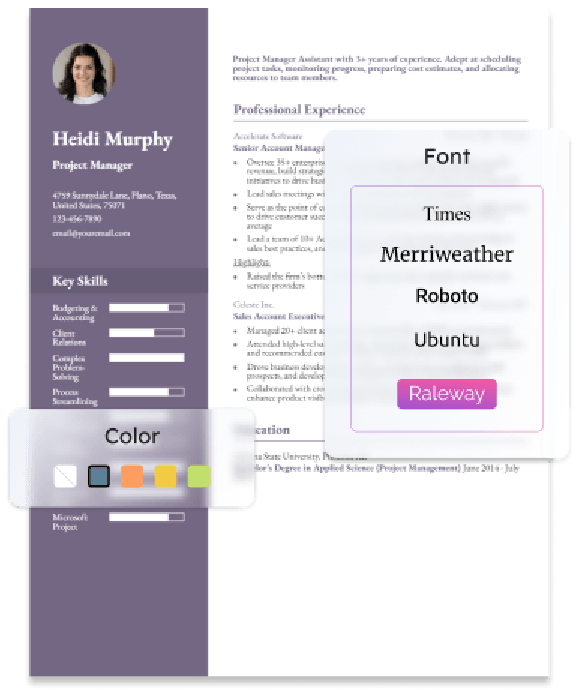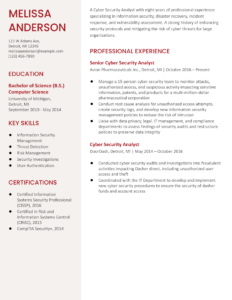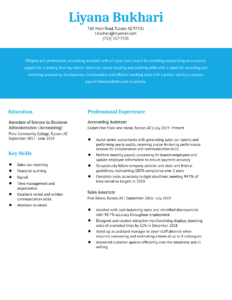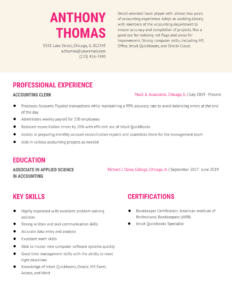How To Write a Modern Resume
In today’s hiring climate, employers have nearly unlimited candidate information at their disposal. A job opening draws dozens, if not hundreds, of applications. Each application can include not just a resume and cover letter but links to the candidate’s online portfolio, LinkedIn profile, or personal website. Hiring managers are also increasingly expected to look up candidates’ online presence for more background and any red flags.
In this environment, it’s harder to hold a hiring manager’s attention. If they’re at all unsure about your application, they’ll just move on to the next one. So the key to a good modern resume is making it concise. Virtually any resume today has one core (unstated) message: “I can excel in the position you’re looking to fill.” The more you focus on that message, and the more quickly you get it across, the better luck you’ll have landing interviews for your target job.
Below you’ll find tips on keeping your resume concise so it performs well in the modern job search.
- Entry-level
- Mid-career
- Senior-level
1. Write a dynamic profile summarizing your qualifications
In a brief paragraph or bullet list at the top of your resume, catch hiring managers’ attention by giving the three to five main reasons you can excel in your target job. These may come from your work history or another area of your background, such as education or volunteer experience. A good profile makes the hiring manager’s job easier by letting them see your top qualifications in just a few seconds. That way, they don’t have to read the whole document to know you fit the role.
(Note, most job seekers find it easier to write their profile last.)
Entry-Level Profile Example
Hardworking Management Consultant who is an IT expert and former systems analyst with an MBA in Business Technology Management from Carnegie Mellon University. Recognized for work speed, quality, and reliability at both McKinsey and Highmark.
Mid-Career Profile Example
Occupational therapist with nearly seven years of experience in a hospital setting. Committed to helping patients regain independence and navigate a smooth return to daily life following recovery from illness, injury, or major surgery. Build productive relationships with nurses, providers, case managers, physical therapists, and respiratory therapists. Expertly balance various duties and priorities in a fast-paced health care environment.
2. Add a results-focused professional experience section
One of the fastest ways to impress hiring managers on your resume is by giving examples of your success in the type of role you’re seeking. Detailed examples help employers visualize the impact you’d have on their organization.
For each job in your recent work history, brainstorm your duties, projects, and achievements on a separate document. Then, choose the most relevant ones to feature in your experience section, setting them off as bullet points. Be ruthless about omitting details that don’t speak to your target job, even if they’re recent or objectively impressive. By leaving out unnecessary info, you’ll keep your experience section concise and focused on points that quickly connect with the hiring manager’s needs.
Mid-Career Professional Experience Example
Occupational Therapist, NY-Presbyterian Hospital, New York, NY | April 2019 to present
- Guide patients through ADLs such as bathing, dressing, and food preparation to support recovery and gauge readiness for discharge from hospital
- Collaborate with physical therapist to help determine and recommend the next phase of each patient’s recovery, drawing on broad knowledge of available rehab, home health, and other services
- Recommend appropriate DME such as wheelchairs, walkers, and leg braces
- Praised by colleagues and managers for outstanding efficiency, collaboration, and dedication to patient outcomes
Senior-Level Professional Experience Example
Chief Operating Officer (COO), YCW Corp., San Diego, CA | October 2017 to Present
- Guided a cost reduction initiative that raised the company’s bottom line by $700K in 6 months
- Built productive partnerships with senior leaders of five major departments
- Drove five successful change initiatives to create a more inventive and collaborative work culture
3. Include your education and relevant certifications
Aside from basic details on any college degree(s) you’ve earned, only add information that relates to your current career goals. The purpose of these sections is to show you have plenty of knowledge about the role the hiring manager wants to fill, more than general insights.
For each degree or certification you include, add the acronym in parentheses, e.g., “Master of Business Administration (MBA).” Acronyms make it easier for hiring managers to quickly register your credentials when they’re first looking over your resume.
Below are templates and examples to help you format your education and certification details. Note, optional template areas appear in [brackets].
Education
Template
- Degree Name — [Major, Minor], School Name, City, ST or online | [Year]
- [Select Coursework]
Example
- Master of Science (MS) – Occupational Therapy, Columbia University, New York, NY | 2015
Certification
Template
- Certification Name or Title, [Awarding Organization] | [Year]
- [Description]
Example
- Certified Management Consultant (CMC), Institute of Management Consultants | 2016
4. List key skills and proficiencies
Add a key skills section to show the various ways you can contribute to your target job. These may include your soft and hard skills or specific products or programs you’re versed in. Like the profile, this section should give hiring managers an overview of your top selling points so they can quickly see if your application is worth a closer look.
Below are some common skills and keywords to consider for your resume:
| Key Skills and Proficiencies | |
|---|---|
| Business needs assessment | Client satisfaction and retention |
| Complex problem-solving | Cost reduction and elimination |
| Cross-team collaboration | Efficiency improvement |
| Inventory management | Lean manufacturing |
| Market strategy development | Microsoft Office Suite |
| Process streamlining | Project and program management |
| Quality assurance | Reporting and documentation |
| Revenue and profit growth | Risk management and mitigation |
| Staff training and development | Stakeholder relations |
| Strategic business development | Talent hiring and retention |
| Task prioritization | Team leadership and motivation |
| Time management | Vendor contract negotiations |
How To Pick the Best Modern Resume Template
In keeping with a concise approach, choose a simple template that lets the hiring manager quickly spot your best career details. Select a clear resume font, and avoid any template with a colorful or elaborate design. The more complicated your layout, the less likely it’ll be to keep the reader’s interest. Also, ensure the template complies with applicant tracking systems (ATS) used by employers to screen resumes.
Modern Text-Only Resume Templates and Examples
- Entry-Level
- Mid-Career
- Senior-Level
Raymond Ortiz
New York, NY 12345 | (123) 456-7890 | [email protected] | www.linkedin.com/example
Profile
Occupational therapist with nearly seven years of experience in a hospital setting. Committed to helping patients regain independence and navigate a smooth return to daily life following recovery from illness, injury, or major surgery. Build productive relationships with nurses, providers, case managers, physical therapists, and respiratory therapists. Expertly balance various duties and priorities in a fast-paced health care environment.
Key Skills
- Cross-functional collaboration
- DME
- Home and workplace evaluation
- Hospital discharge planning
- Patient and family relations
- Patient consult and assessment
- Reporting and documentation
- Task prioritization
- Treatment planning
Professional Experience
Occupational Therapist,NY-Presbyterian Hospital, New York, NY | April 2019 to present
- Guide patients through ADLs such as bathing, dressing, and food preparation to support recovery and gauge readiness for discharge from hospital
- Collaborate with physical therapist to help determine and recommend the next phase of each patient’s recovery, drawing on broad knowledge of available rehab, home health, and other services
- Recommend appropriate DME such as wheelchairs, walkers, and leg braces
- Praised by colleagues and managers for outstanding efficiency, collaboration, and dedication to patient outcomes
Occupational Therapist,Tisch Hospital, New York, NY | July 2015 to April 2019
- Assisted patients with ADLs to facilitate recovery and discharge planning
- Consulted with patients to discuss and clarify their goals for regaining mobility and resuming daily work and life activities
- Maintained open communication with nurse staff, offering a detailed update after each patient consult
- Developed and honed strong skills in patient relations and team collaboration
Education
Master of Science (MS) – Occupational Therapy, Columbia University, New York, NY | 2015
Bachelor of Science (BS) – Psychology, University of Syracuse, New York, NY | 2011
Certification & License
Certified, National Board for Certification of Occupational Therapy (NBCOT) | 2015
Occupational Therapy License, New York | 2015
Frequently Asked Questions: Modern Resume Examples and Advice
What are common action verbs for modern resumes? -
One of the best ways to enhance your resume is by starting each bullet point with a strong action verb. These help you keep the hiring manager’s attention and reflect the dynamic nature of your experience. The best verbs will show your having created or improved things in past positions.
The following list can help you find a good mix of verbs for your resume:
| Action Verbs | |
|---|---|
| Automated | Averted |
| Coordinated | Created |
| Decreased | Developed |
| Eliminated | Enhanced |
| Expedited | Garnered |
| Generated | Improved |
| Increased | Introduced |
| Launched | Lowered |
| Organized | Prevented |
| Produced | Raised |
| Ranked | Reduced |
| Shortened | Streamlined |
| Strengthened | Updated |
| Won | |
How do you align your modern resume with a job posting?-
First, look closely at the job post text and highlight words that are repeated, emphasized, or otherwise seem important. Compare these highlighted phrases to the language you’re using in your resume, particularly the profile and key skills sections. Then seek ways to align your resume language with the job post while not copying phrases or misstating your background.
For example, say the company seeks someone collaborative. Emphasize that part of your experience in your profile with a line like “Thrive in collaborative work settings” or in your key skills section with a term like “cross-team collaboration.” Or say the company has many non-English speaking customers. Highlight your foreign language skills both in your profile and as a separate section farther down the document.
Also, consider adding brief descriptions of the places you’ve worked in [brackets] right next to or below the company name. Company descriptions let you show any similarities between your past employers and the one who posted the job. For example, maybe you’ve worked for companies of a similar size or industry. Or maybe you’ve worked at organizations with a similar mission or leadership philosophy. By adding these details to your descriptions, you can make your resume more relevant to the job opening at hand.
What is the best modern resume format? -
Most job seekers today should use the combination (or hybrid) format. True to its name, this format combines two features of traditional resume formats: the chronological format’s experience section and the functional format’s profile section. (The resume examples on this page all use combination format.)
By fusing these two features, a combination resume offers the best of both worlds. The experience section lets you outline your recent work history – essential information for most employers. At the same time, the profile section lets you display your career highlights at the top, regardless if they’re from that work history or another part of your background. As a result, you can present yourself clearly and strategically. With this format, you give hiring managers the best view of your experience and relevant strengths, so they can make an informed decision to call you for an interview.

Craft your perfect resume in minutes
Get 2x more interviews with Resume Builder. Access Pro Plan features for a limited time!







